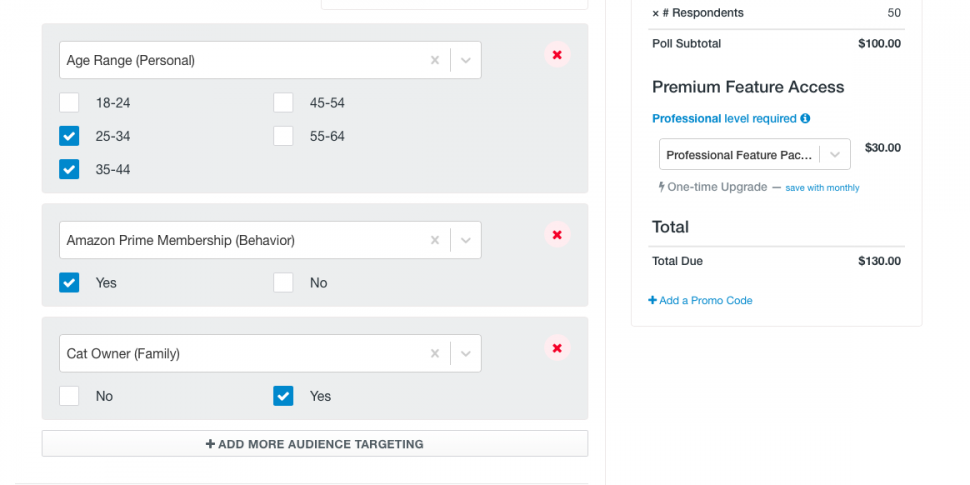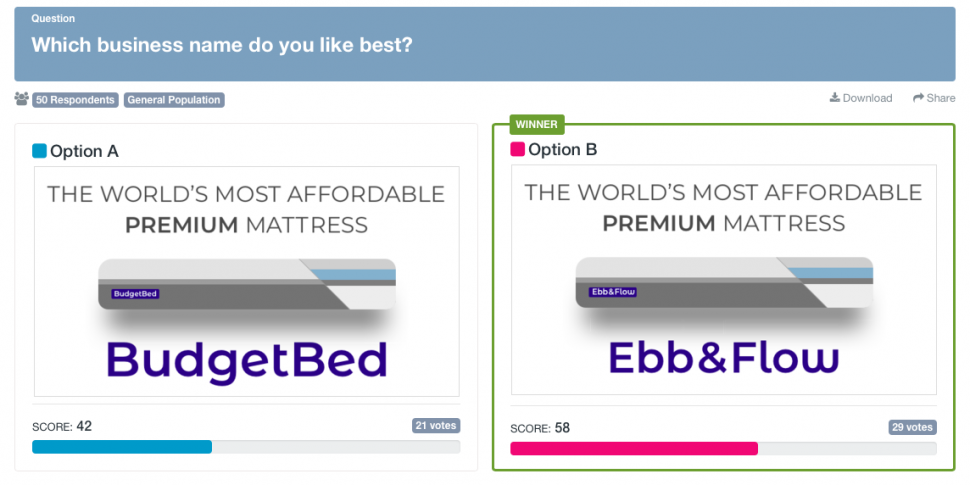Wondering about the best way to split test your Amazon listings? Kim Kohatsu, PickFu’s Director of Marketing, recently sat down with Rob Stanley from Feedbackwhiz to discuss how to leverage PickFu as a split testing solution.
Feedbackwhiz builds innovative seller management software for Amazon sellers, including order management, email automation, and feedback campaigns. Feedbackwhiz focuses on helping merchants boost their businesses and is already used by thousands of Amazon sellers.
Knowing there are Amazon sellers in both of our audiences, Kim and Rob met virtually for a chat on the Feedbackwhiz YouTube channel. They discussed the process and costs of Amazon split testing, and dove into several examples of how Amazon sellers can use PickFu. Watch the interview below or keep reading to learn how PickFu works for you and your Amazon store.
How PickFu approaches split testing
When it comes to split testing, PickFu polls are versatile and enable you to test any part of your Amazon listing. You can test featured images, product names, logos, product descriptions, and more.
When you create a poll on PickFu, start by inputting your question. For example, ask “Which image do you prefer?” or “Which design do you prefer?” You can input up to eight different options in a single poll, and these options can be images, text, links, or embedded videos.
If you have more than two options, you can either have respondents rank the options in the order they prefer or set up head-to-head matchups, which is a more complete way of polling.
The perks of testing outside of Amazon
Since PickFu polling happens outside of Amazon, your listings don’t have to be live to start testing. You can run polls for idea validation before going into production or committing to inventory. For example, you can determine which colors will be most popular and which designs to move forward with.
If you already have live listings, using PickFu means there’s no risk of losing sales if the new variant performs worse than the original. You don’t have to change anything in your listing until the poll results have shown it will perform better.
Another benefit of testing outside of Amazon is the ability to compare your products to a competitor or category leader. You can match your product directly against another to see how it fares with respondents. Since respondents leave written feedback along with voting, you discover what you’re doing well and can work that into the messaging of your listings and branding.
Use PickFu for insight on your pricing
Along with a voting system, PickFu allows for open-ended feedback. If you’re stuck on pricing your products, you can turn to respondents for their opinions. Try running a poll with questions such as:
- How much would you pay for this product?
- Which product looks more expensive?
- Do you think $14.99 is a fair price?
At PickFu, we’ve also found from previous polls that if you list a price in the details, people will leave their opinion on price anyways. You may see feedback such as, “I prefer the photo from Option A, but I wouldn’t pay that price for it.”
How PickFu protects the confidentiality of your business
When running your own e-commerce business, especially with proprietary products you’ve created, confidentiality is a top concern. Rest assured that PickFu understands this, and we have several measures in place to protect the confidentiality of your ideas, products, and business.
Before taking part in any polls, every respondent signs a thorough non-disclosure agreement (NDA). Respondents are restricted from taking or sharing anything they see within a poll.
By default, new polls are added to the public gallery, where sellers can get ideas on how to use polls and see how effective they are. If you don’t want your poll included in this public gallery, you can make the poll private when setting it up. This ensures that anything you share in the poll won’t be indexed by search engines and stays between you and the respondents.
Who are the PickFu respondents?
We use a variety of online services to find our respondents, with everyone based in the United States and a native English speaker. On the back-end, we have developed proprietary quality controls that include internal rating systems and protecting you from spammers. We take quality seriously and are always working to ensure that respondents are giving insightful feedback.
While we have gathered a range of people to respond to PickFu polls, you have the ability to customize your audience. You can choose a general audience which is a mix of men and women, different age groups, and different interests.
You can also specify the audience who votes in your poll. One popular option for e-commerce sellers is polling Amazon Prime members. If you’re targeting your product to a specific kind of person, you can use filters like gender, age range, educational level, and income. For example, if you have a high-end product, you can target people who are making more than $100k per year.
You can choose multiple filters to get a specific audience, such as female homeowners or male mobile gamers in their 20s. We’ve also added categories that are especially beneficial for e-commerce users, such as cat owners or dog owners for pet products. Other information we gather from respondents includes
- exercise habits
- cooking habits
- if they use cosmetics
- if they take nutritional supplements
- the type of mobile device used
- if they’ve donated to a Kickstarter campaign before
By combining different categories, you can niche your poll audience down to the same type of shoppers you are targeting with your products.
How long does a PickFu poll take to complete?
Once you’ve created and submitted your poll, we immediately find respondents to vote. Depending on your targeting parameters, this can happen quickly. If you choose a general audience or something simple like ’50 females,’ the poll may finish in less than 15 minutes.
If you are specific with your targeting, it can take longer for the poll to complete. When we did a poll about Mother’s Day, we targeted mothers by combining female respondents with those who have children. This poll took two hours to complete.
There are other factors involved in the speed of poll completion. If you are running a poll at night or over the weekend when fewer people are online, it may take longer to finish. On average though, most polls are completed in under an hour.
How PickFu compares to other Amazon testing tools
When you compare PickFu polls to other Amazon split testing tools such as Splitly or Listing Dojo, there’s one major difference that sets us apart: we’re people-powered. Thanks to our live respondents, business owners gain more insight with PickFu polls than they could with other split testing tools.
For example, one e-commerce seller was developing a garden product specifically for people who live in apartments and don’t have much outdoor space. The product they were creating would allow these apartment dwellers to grow a garden in a compact space.
The seller created a poll to test out two product names, Patio Harvest vs. Porch Farmer. Patio Harvest easily won the poll with 76% of the vote, but the real insights came from the written feedback.
Many respondents commented that apartments don’t have ‘porches,’ while other respondents said they don’t consider themselves ‘farmers.’ Because of these reasons, a lot of the feedback said the name Porch Farmer didn’t resonate with them.
A traditional split testing or keyword tool would never be able to give you this specific kind of feedback. Product names, packaging, and color preferences are personal choices for consumers, so algorithmic feedback can’t provide this kind of insight.
PickFu may prove your assumptions wrong
As Amazon sellers and business owners, it’s easy to get tunnel vision. You favor ideas that you, your spouse, or your friends like and can get stuck on that path.
We’ve seen polls where we were sure we knew which option would win. For example, one seller ran a poll for a premium but affordable mattress and was trying to decide between calling it Ebb & Flow or Budget Bed. Because we enjoy alliteration, we were confident Budget Bed would win.
Contrary to our assumption, Budget Bed ended up polling poorly. Thanks to the written feedback, we learned that respondents thought Budget Bed sounded too cheap and therefore thought it would be a low-quality product.
In the written feedback of your polls, you’ll see themes and commonalities arise. Your audience will tell you which way to go and what to choose for your products.
How does PickFu pricing work?
Pricing for PickFu polls is simple. The base price is $50 for two options with 50 responses, and this enables you to test images, text, links, or embedded videos.
When you add additional options (up to eight per poll) or audience targeting parameters, the price of the poll goes up. As you build your poll, a pricing calculator gives you an updated price before you finalize everything and check out. You’ll always know exactly what your costs are before you pay.
On the other hand, traditional A/B testing with live Amazon listings can be unpredictable and expensive. You have to pay for the automation software to run your tests, along with running ads to build enough traffic to gather sufficient data.
PickFu is always a flat fee, so you know what you’re getting into. There are no surprises since you choose how much you want to pay based on the options you select.
Move from split testing to collecting customer reviews
Once you’ve run a few PickFu polls and optimized your Amazon listings, you’ll see an increase in traffic and purchases. But the data and feedback don’t end there! Once customers have purchased something from you, it’s crucial to get product reviews from them. Reviews give you further insight on their impression of your product, tell you what to keep or change, and encourage other shoppers to buy. Feedbackwhiz is an email marketing software tool that makes collecting reviews from buyers easier by automating the process for you.






